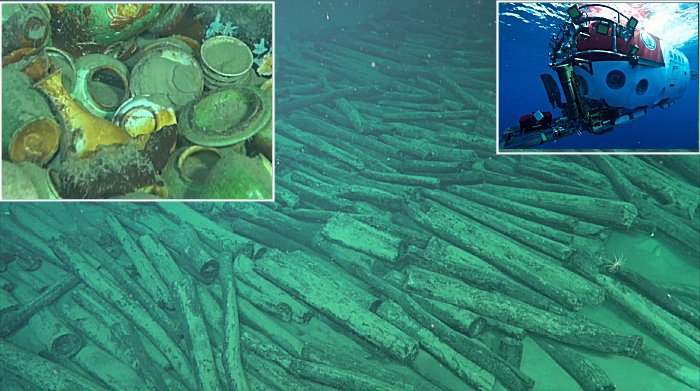Conny Waters - AncientPages.com - Two ancient shipwrecks, most likely dated to the mid-Ming Dynasty (1368-1644), were discovered about 1,500 meters under the sea level in South China Sea, the coastal city of Sanya, Hainan province.
Over 100,000 cultural relics, mainly porcelains - recently found on Northeast Continental Slope No 1 Shipwreck of the South China Sea. Photo provided to China Daily.
The first of the shipwrecks was found in October last year. It is also the first time that China discovered a site of large-scale ancient shipwreck in the deep sea, according to the researchers.
One of them was found with a large collection of porcelain artifacts, dating back to the Ming Dynasty. The other contained still well-preserved timber.
The two are named by researchers as Northwest Continental Slope No 1 and No 2 shipwrecks in South China Sea, informed the National Cultural Heritage Administration.
This is an important China conducted its first archeological exploration of the No. 1 wreck in the slope undercurrent of the northwestern South China Sea on Saturday.
Neatly placed wooden logs are found on Northeast Continental Slope No 2 Shipwreck of the South China Sea. Photo provided to China Daily
The "Deep Sea Warrior" manned submersible dove 1,500 meters and photographed the area to place permanent map markers.
However, a large number of relics (over 100,000 cultural pieces) from the No 1 shipwreck were scattered across approximately a 10,000-square-meter area.
The shipwreck still remains buried in sand, while some parts are covered by a 3-odd-meter- thick layer of relics.
On the No 2 shipwreck, about 20 kilometers away, numerous processed wooden logs are neatly placed, together with small number of ceramics. Based on some porcelains that were salvaged from the sites, the No 1 shipwreck was probably from reign of Zhengde (1505-21), and the No 2 was from reign of Hongzhi (1488-1505), writes South China Morning Post.
"The well-reserved relics are of high historical, scientific, and artistic values," Yan said. "It can be a world-class archaeological discovery in deep sea.
The manned submersible - Deep Sea Warrior” can reach a depth of 4,500 meters. Image credit: cgtn
"The findings are key evidences of ancient Maritime Silk Road and is a major breakthrough studies for history of Chinese overseas trade, navigation, and porcelains," he added.
Yan Yalin, director of archaeology department of the National Cultural Heritage Administration, informed that products of Jingdezhen, Jiangxi province and Longquan Kiln in present-day Zhejiang province, both key hubs for porcelain making and export of ancient China, dominated the discovered porcelains on the No 1 site.
Recent underwater discoveries provides key references for understanding changing historical trade routes across the South China Sea, and as Tang Wei, director of the National Centre for Archaeology said “discovery of inbound and outbound ancient ships in the same area demonstrated significance of this route. It helped studies on reciprocal flow of Maritime Silk Road."
Written by Conny Waters - AncientPages.com Staff Writer
